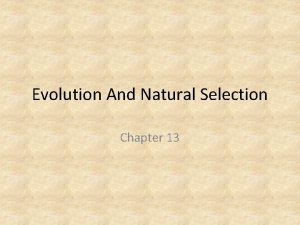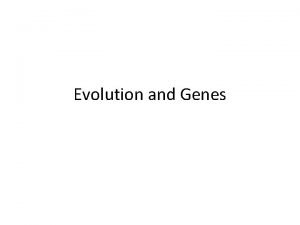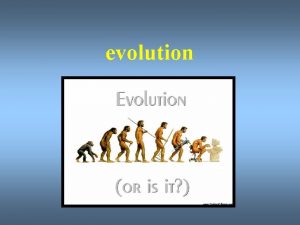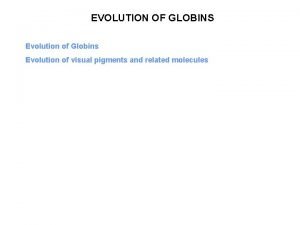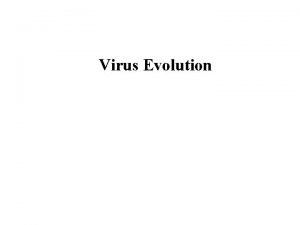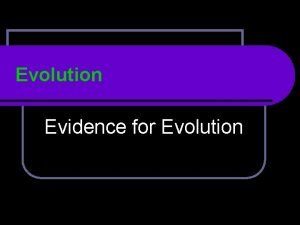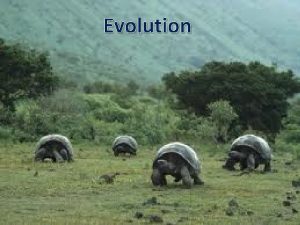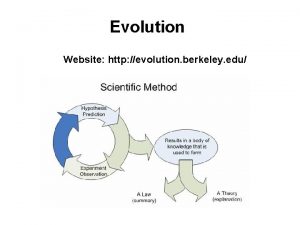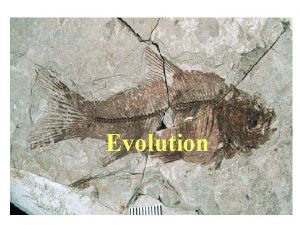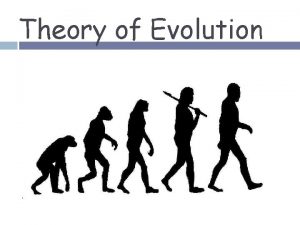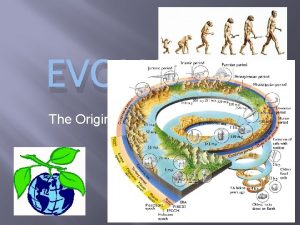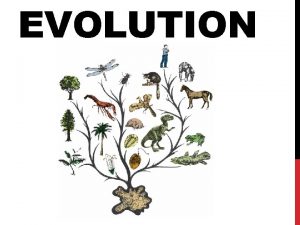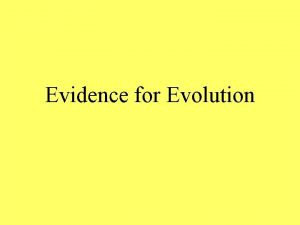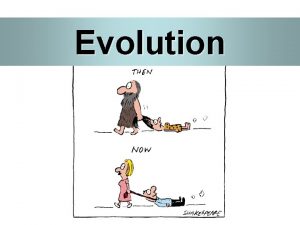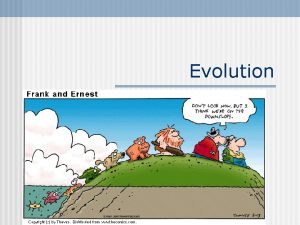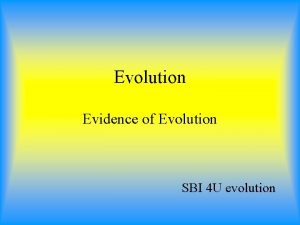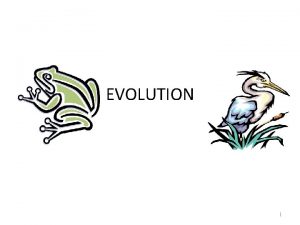EVOLUTION Chapter 21 CHAPTER 21 EVOLUTION Evolution the




























- Slides: 28

EVOLUTION Chapter 21 CHAPTER 21

EVOLUTION Evolution: the processes that transformed life on Earth from earliest forms to the enormous diversity of today § Life changes § Changes in the genetic make-up of populations over time § From adaptations (changes) to different environments and the origin of new species

CHARLES DARWIN Darwin: Father of Evolution § Wrote “On the Origin of Species by Means of Natural Selection” § Focused on adaptations to different environments as the origin of new species § Made 2 points: 1. “Descent with Modification” § Darwin’s words for evolutionary change § Current species evolved from ancestral species 2. Natural Selection: mechanism for adaptive evolution § I. e. differential reproductive success § The mechanism for change? § NOTE: but only for heritable traits

TERMINOLOGY Alleles: different forms of a gene; A or a Genotype: the genetic make-up of an organism; AA or Aa, or aa Phenotype: the observable trait; purple flower color Species: a group of individuals that can exchange genetic material through interbreeding to produce viable, fertile offspring (i. e. share alleles through reproduction). Genetically distinctive. Populations: an interbreeding group of organisms of the same species living in the same geographical area Gene pool: all the alleles present in all individuals in a species in a given population

GENETIC VARIATION 21. 1 Genetic variation is the result of differences in DNA sequences among individuals in a population 2 causes of genetic variation: 1. Mutation 2. Sexual recombination Differences in genotype among individuals in a population

WHAT CAUSES GENETIC VARIATION? Mutations: create new variations § Somatic § Germ-line…can be passed on to next generation Deleterious Neutral Advantageous…to be best adapted to their environment Recombinations: shuffle mutations for new combinations

ALLELE FREQUENCIES 21. 2 Information about allele frequencies is key to understanding patterns of genetic variation Allele Frequency = # of copies of an allele total # of alleles in population Example 1: The genotypes for pea color in Mendel’s pea plants are AA – yellow pea plant Aa – yellow pea plant aa – green pea plant What are the frequencies of the a and A alleles if every plant is green?

ANSWER Allele Frequency = # of copies of an allele total # of alleles in population Example 1: If every plant is green, then they are all aa genotypes Only the a allele is present in the population Allele frequency of a is 100% and for A is 0% Population is FIXED for that allele when it exhibits only one allele at a given gene

ALLELE FREQUENCIES Allele Frequency = # of copies of an allele total # of alleles in population Example 2: A population of 100 pea plants has the following genotype frequencies: 50% aa, 25% AA= 100% What is the frequency of a?

ANSWER Allele Frequency = # of copies of an allele total # of alleles in population Example 2: How many copies of a allele are present? There are 50 aa plants and 25 Aa plants (50 x 2) +25 = 125 copies of a Divided by 100 diploid plants = 200 alleles in population Therefore, 125/200 = 62. 5% a

MEASURING GENOTYPE/ALLELE FREQUENCIES Observable traits Gel electrophoresis DNA sequencing

OBSERVABLE TRAITS 4 phenotypes, 6 genotypes from 3 alleles at 1 ge Genetic diff in color from variation in 1 gene

GEL ELECTROPHORESIS Proteins extracted from diff individuals migrate through a gel when electric charge is applied Differentiates proteins by charge and size. due to diff in amino acid sequence

DNA SEQUENCING Allows the look at any variation in DNA sequence, not just different proteins Example: observe differences in the alcohol dehydrogenase (ADH) gene in 50 fruit flies In sequencing the gene, we find 70 that have an A and 30 that have a G at a given position in the gene. § Allele frequency for A = 70/100, or 70% § Allele frequency for G = 30/100, or 30% § %A + %a = 1

EVOLUTION 21. 3 Evolution is a change in the frequency of alleles o genotypes over time Changes in a population’s genetics over time By changing allele or genotype frequency Natural selection works on the individual, but it is the population that evolves NOTE: Population is the smallest unit to evolve, not an individual Bottom Line: organisms best suited (adapted) to their environment live longer, reproduce more, and put their better genes/variants into the population

5 HARDY-WEINBERG CONDITIONS Hardy-Weinberg Equilibrium: situation in which evolution does not occur There can be no differences in the survival success of individuals. and reproductive Where p=%A and q=%a Eq for allele frequencies: p (%A) + q (%a) = 1 Eq for genotype freq: p 2 (AA)+2 pq(Aa)+q 2 (aa) = 1

HARDY-WEINBERG CONDITIONS Very large population size § The population must be sufficiently large to prevent sampling errors. No migration (isolation from other populations) § Gene flow happens all the time (exception: islands) No net mutations § Mutations happen all the time § It is the raw material for natural selection Random mating § Most animals do nonrandom mating § Inbreeding: individuals of a population mate with close neighbors § Assortative mating: individuals mate with partners that look like each other No natural selection § Mutations in a population makes natural selection possible to be best suited to that environment

QUICK CHECK When we find a population whose allele frequencies are NOT in Hardy-Weinberg equilibrium, what can and can’t we conclude about that population?

ANSWER We can conclude: § The population IS evolving We cannot conclude: § The mechanism causing it to evolve: whether selection, migration, mutation, genetic drift or non-random mating

NATURAL SELECTION LEADS TO ADAPTATION 21. 4 Natural selection leads to adaptations, which enhance the fit between organism and its environment Charles Darwin and Alfred Russel Wallace independently conceived the idea of natural selection Selection: differential success of alleles Natural selection: the differential reproductive success of genetic variants (to be best suited to that environment); increases the frequency of beneficial alleles, leading to adaptation § A harmful allele is eliminated over time—negative selection § A beneficial one increases its frequency –positive selection

HETEROZYGOTE ADVANTAGE Balancing selection seen in Africa regarding malaria. Two alleles of gene for hemoglobin are A and S Heterozygotes (As) have advantage with malaria over either AA or ss AA = vulnerable to malaria ss = sickle cell disease As = do not

PATTERNS OF NATURAL SELECTION Birth weight Drug resistance Birds bills

STABILIZING SELECTION

ARTIFICIAL SELECTION Selected by breeders; it is a form of directional selection; found in ag

SEXUAL SELECTION Promotes traits that increase an individual’s access to reproductive opportunities Fitness: a measure of the extent to which the individuals genotype is represented in the next generation

OTHER FACTORS CAUSING CHANGES IN ALLELE FREQUENCIES 21. 5 Migration, mutation, and genetic drift are non-ada mechanisms of evolution Migration: the movement of individuals from one population to another; resulting in gene flow…. the movement of alleles from one population to another § Homogenizing effect Mutation: increases genetic variation by being the source of new alleles; the raw material on which other forces act Genetic Drift: a change in the frequency of an allele due to the random effects of small population size (sampling error) § Bottleneck Effect…natural disaster § Founder Effect……founding fathers

QUICK CHECK Why, of all evolutionary forces, is selection the only one that can result in adaptation?

ANSWER Adaptation is the fit between an organism and its environment. Of all the evolutionary mechanisms, only selection causes allele frequencies to change based on how they contribute to the success of an individual in terms of survival and reproduction. This means that allele frequencies in the next generation are governed by the environment.
 Hát kết hợp bộ gõ cơ thể
Hát kết hợp bộ gõ cơ thể Ng-html
Ng-html Bổ thể
Bổ thể Tỉ lệ cơ thể trẻ em
Tỉ lệ cơ thể trẻ em Chó sói
Chó sói Chụp phim tư thế worms-breton
Chụp phim tư thế worms-breton Bài hát chúa yêu trần thế alleluia
Bài hát chúa yêu trần thế alleluia Môn thể thao bắt đầu bằng từ chạy
Môn thể thao bắt đầu bằng từ chạy Thế nào là hệ số cao nhất
Thế nào là hệ số cao nhất Các châu lục và đại dương trên thế giới
Các châu lục và đại dương trên thế giới Công thức tính độ biến thiên đông lượng
Công thức tính độ biến thiên đông lượng Trời xanh đây là của chúng ta thể thơ
Trời xanh đây là của chúng ta thể thơ Mật thư tọa độ 5x5
Mật thư tọa độ 5x5 Làm thế nào để 102-1=99
Làm thế nào để 102-1=99 Phản ứng thế ankan
Phản ứng thế ankan Các châu lục và đại dương trên thế giới
Các châu lục và đại dương trên thế giới Thơ thất ngôn tứ tuyệt đường luật
Thơ thất ngôn tứ tuyệt đường luật Quá trình desamine hóa có thể tạo ra
Quá trình desamine hóa có thể tạo ra Một số thể thơ truyền thống
Một số thể thơ truyền thống Cái miệng bé xinh thế chỉ nói điều hay thôi
Cái miệng bé xinh thế chỉ nói điều hay thôi Vẽ hình chiếu vuông góc của vật thể sau
Vẽ hình chiếu vuông góc của vật thể sau Nguyên nhân của sự mỏi cơ sinh 8
Nguyên nhân của sự mỏi cơ sinh 8 đặc điểm cơ thể của người tối cổ
đặc điểm cơ thể của người tối cổ Ví dụ về giọng cùng tên
Ví dụ về giọng cùng tên Vẽ hình chiếu đứng bằng cạnh của vật thể
Vẽ hình chiếu đứng bằng cạnh của vật thể Tia chieu sa te
Tia chieu sa te Thẻ vin
Thẻ vin đại từ thay thế
đại từ thay thế điện thế nghỉ
điện thế nghỉ





























